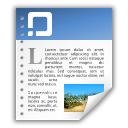| dc.contributor.author | Richards, Megan | |
| dc.date.accessioned | 2008-04-07T21:32:54Z | |
| dc.date.available | 2008-04-07T21:32:54Z | |
| dc.date.issued | 2008-04-07T21:32:54Z | |
| dc.identifier.uri | http://hdl.handle.net/1803/478 | |
| dc.description | Teaching and Learning Department Capstone Project | en |
| dc.description.abstract | Abstract
Literature circles are an important component of the literacy curriculum in elementary classrooms. Literature circles are small groups of students with heterogeneous abilities talking together about a shared text. The look and sound of literature circles varies widely across classrooms. In general, however, they involve student-led discussions driven more by students' questions and connections with the text than by the teacher's agenda. Literature circles provide an opportunity for students to co-construct the meaning of a text. Research has shown that literature circles allow students to engage in discussion topics that are important and meaningful to them and in doing so promote a deeper understanding of the text. Having a dialogue surrounding literature helps students recognize a purpose for reading and allows them to act as readers in an authentic situation. In the process, students use language in multiple ways and engage in higher order thinking. Unfortunately, many teachers avoid implementing literature circles in the classroom because of the work and time involved in setting them up and because of the classroom management they require. However, with careful preparation teachers can overcome the difficulties to provide students with all of the benefits of literature circles. This project further explores literature circles and provides the author's vision of how she would implement literature circles in her own third grade classroom. The literature review provides the theoretical basis providing the foundation for literature circles. In addition, the literature review addresses the practical aspects of literature circles including the teacher's role, the general organization, how to get started with implementation, and how to assess students. Following the literature review is a sample curriculum overview outlining the transition into literature circles in a third grade classroom and a rationale that more explicitly connects theory and practice. Additional materials for use in the classroom are included. | en |
| dc.description.abstract | Peabody College of Education and Human Development | |
| dc.description.tableofcontents | Literature Review, P. 5; Introduction, P. 5; Theoretical Framework, P. 5; Teacher's Role, p. 8; General Organization, P. 12; Getting Started, P. 18; Assessment, P. 20; Conclusion, P. 22; Curriculum Overview, P. 24; Curriculum Rationale, P. 28; References, P. 34; Classroom Resources and Materials, P. 37; Discussion Topics, P. 37; Discussion Guidelines/Elements, P. 37; Weekly Group, Evaluation Form, P. 38; Student Self-Evaluation Form, P. 39; Teacher Group Observation Form, P. 40 | en |
| dc.format.extent | 150528 bytes | |
| dc.format.mimetype | application/msword | |
| dc.language.iso | en_US | en |
| dc.publisher | Vanderbilt University. Peabody College | |
| dc.subject | Literature Circles | en |
| dc.subject.lcsh | Reading (Elementary) -- Activity programs | en |
| dc.subject.lcsh | Literacy -- Study and teaching (Elementary) | en |
| dc.subject.lcsh | Group reading | en |
| dc.subject.lcsh | Children -- Books and reading | en |
| dc.title | The "How-to" and "Whys?" of Literature Circles | en |
| dc.type | Thesis | en |
| dc.description.department | Department of Teaching and Learning | |

